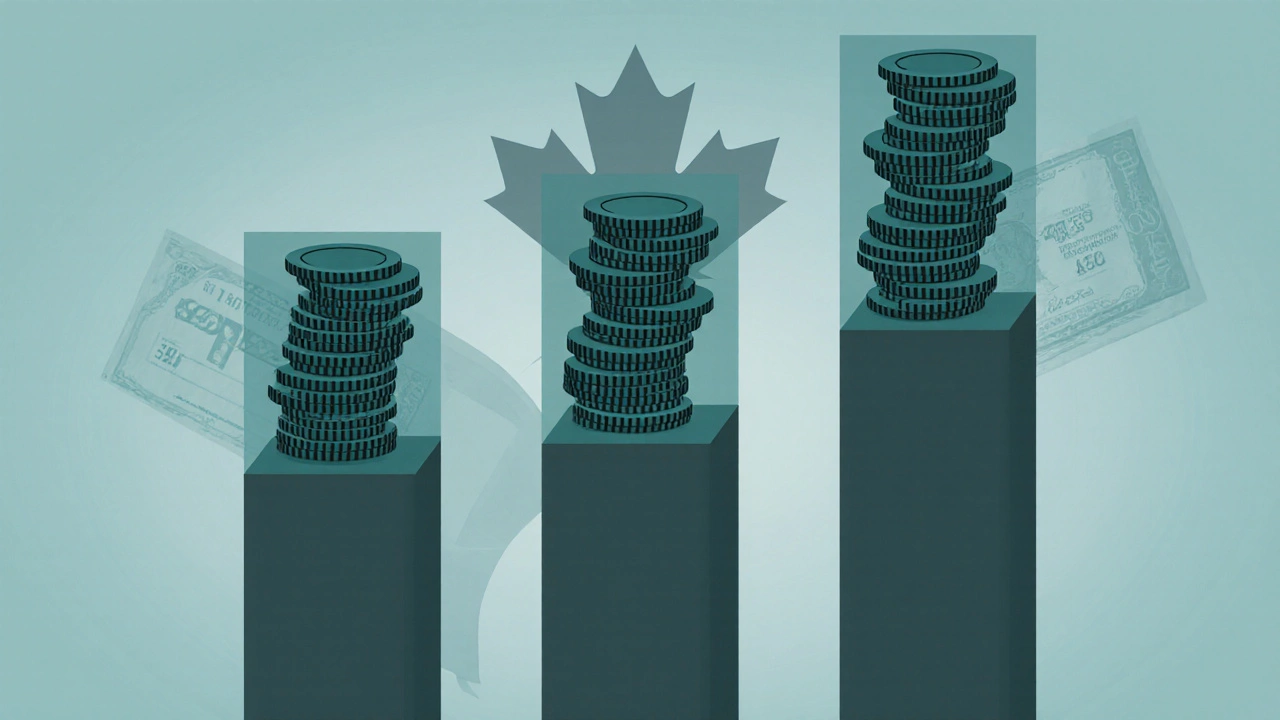How Long Will $500,000 Last in Retirement? A Detailed Breakdown
 Oct, 11 2025
Oct, 11 2025
Retirement Savings Calculator
Your Retirement Inputs
Results
Estimated Fund Longevity
Not calculated yet
With your current parameters, your retirement savings should last approximately Not calculated yet years.
Key factors: Not calculated yet
Imagine you have half a million dollars tucked away for retirement. How many years will that stash support you once you stop working? The answer isn’t a simple number - it depends on how you spend, invest, and protect that money against rising costs and taxes. Below we walk through the key factors, run realistic scenarios, and give you a step‑by‑step plan to estimate the lifespan of a $500,000 nest egg.
What Drives the Length of Your Retirement Money?
Three core variables shape the longevity of any retirement fund:
- How much you withdraw each year (the withdrawal rate).
- The real return you earn after accounting for inflation.
- The length of time you expect to draw on the fund, often linked to life expectancy.
Each of these interacts with government benefits, taxes, and your spending style. Let’s define the main players.
Retirement Savings is the total amount of money you have set aside to fund your post‑work years, typically held in a mix of investments, cash, and registered accounts. In our case, the figure is $500,000.
Annual Withdrawal represents the amount you pull out of your savings each year to cover living expenses.
Inflation Rate measures how quickly the cost of goods and services rises, eroding purchasing power.
Investment Return is the percentage gain (or loss) your portfolio generates each year before fees and taxes.
Life Expectancy is the age you anticipate living to, which determines the number of withdrawal years needed.
Canada Pension Plan (CPP) & Old Age Security (OAS) are government benefits that provide a baseline monthly income to Canadian retirees.
Tax Rate affects how much of your withdrawal is kept after income tax is applied.
Portfolio Allocation describes the split between equities, bonds, and cash, influencing both risk and expected return.
Step 1: Pick a Withdrawal Strategy
The classic "4% rule" suggests taking 4% of your initial balance (adjusted for inflation) each year. For $500,000, that starts at $20,000. In Canada, the rule works well when combined with CPP/OAS because those benefits cover a chunk of basic expenses.
Other popular rates are 3% (more conservative) and 5% (more aggressive). Let's see how each plays out over a 30‑year horizon with different market assumptions.
| Withdrawal Rate | Annual Start Amount | Assumed Real Return (2% net of inflation) | Years Fund Lasts (No CPP/OAS) |
|---|---|---|---|
| 3% | $15,000 | 2% | ~38 years |
| 4% | $20,000 | 2% | ~30 years |
| 5% | $25,000 | 2% | ~24 years |
Notice how a 1% change in withdrawal rate shifts the fund’s lifespan by 6-8 years. That’s why understanding your actual expense needs-and whether CPP/OAS can cover part of them-is crucial.
Step 2: Add Government Benefits
Most Canadians begin receiving CPP at age 65. As of 2025, a single retiree with average contributions gets roughly $1,300 per month ($15,600 annually). OAS adds about $850 per month ($10,200 annually) for most recipients. Together, that’s $25,800 a year, tax‑free up to a certain income threshold.
If your total annual need is $45,000, the cash you must pull from your savings drops to $19,200. That’s a 3.84% withdrawal on $500,000, slightly higher than the pure 4% rule but offset by the tax‑free nature of CPP/OAS.
When CPP/OAS are factored in, the fund can often stretch beyond the raw 30‑year estimate, especially if you keep your own withdrawals modest.

Step 3: Adjust for Inflation
Canada’s long‑term inflation average hovers around 2.0‑2.5%. If you withdraw a fixed $20,000 each year, that buying power shrinks. The 4% rule automatically adjusts withdrawals for inflation, keeping your lifestyle stable.
For a realistic simulation, assume a 2% inflation rate and a 4% nominal portfolio return (2% real). The table above already incorporates this adjustment.
Step 4: Model Different Investment Returns
Portfolio composition matters. A 60/40 equity‑bond mix historically yields about 5% nominal returns (≈3% real). A more aggressive 80/20 split can push nominal returns to 6%-7% (≈4% real) but brings larger volatility.
Let’s see the effect of a higher real return (4% net of inflation) on the 4% withdrawal rate:
| Real Return | Years Fund Lasts |
|---|---|
| 2% | 30 years |
| 3% | ~36 years |
| 4% | ~44 years |
Higher returns dramatically extend the runway, but they also raise risk. If you’re close to retirement, a conservative allocation may be wiser.
Step 5: Factor in Taxes
Withdrawals from a non‑registered account are fully taxable at your marginal rate. Registered accounts (RRSP, TFSA) have different rules:
- RRSP: Withdrawals are taxed as ordinary income.
- TFSA: Withdrawals are tax‑free, making them the most efficient source for discretionary spending.
Assume a 30% marginal tax rate on non‑registered withdrawals. If you need $19,200 after tax, you must gross $27,430 from a taxable account-raising the effective withdrawal rate to 5.5%.
Strategically using TFSA dollars first, followed by RRSP and finally non‑registered funds, can keep your overall tax burden low and stretch the principal.

Step 6: Build Your Personal Longevity Checklist
- Estimate annual expenses: Include housing, health care, travel, and discretionary items.
- Calculate expected CPP/OAS income: Use Service Canada calculators for a personalized estimate.
- Choose a withdrawal rate: Start with 4% and adjust based on your comfort with risk.
- Set portfolio allocation: Balance growth (equities) with stability (bonds, cash) according to your age and risk tolerance.
- Run scenario simulations: Use a spreadsheet or retirement calculator to see outcomes under low, moderate, and high return assumptions.
- Plan tax‑efficient withdrawals: Prioritize TFSA > RRSP > non‑registered.
- Review annually: Adjust withdrawals for actual inflation, market performance, and any changes in health or lifestyle.
Following this checklist each year keeps you on track and helps you spot when you might need to tighten spending or rebalance investments.
Real‑World Example: Toronto Couple, Age 65
Maria and James retired with $500,000 combined, a $200,000 TFSA, $250,000 RRSP, and $50,000 cash. Their annual expenses are $55,000.
- CPP/OAS provides $25,800 (tax‑free).
- They withdraw $15,000 from the TFSA (tax‑free).
- They need $14,200 more after tax. Assuming a 30% tax on RRSP withdrawals, they must gross $20,286 from the RRSP.
Total first‑year draw is $60,286, a 12% effective withdrawal on the total portfolio-but only 4% of the non‑tax‑sheltered assets. With a balanced 60/40 allocation earning a 3% real return, their model shows the fund lasting about 32 years, taking them to age 97-well beyond average life expectancy.
Key Takeaways
- The lifespan of $500,000 hinges on withdrawal rate, inflation‑adjusted returns, and supplementary income like CPP/OAS.
- Using a 4% inflation‑adjusted withdrawal, a modest 2% real return, and full CPP/OAS benefits gives roughly 30 years of coverage.
- Higher returns or lower withdrawal rates can push the horizon to 40+ years, while aggressive spending can deplete the fund in under 25 years.
- Tax‑efficient withdrawal sequencing (TFSA → RRSP → non‑registered) stretches your money the most.
Frequently Asked Questions
Can I rely solely on $500,000 without CPP/OAS?
If you have no government benefits, a 4% withdrawal with a 2% real return would last about 30 years. Without any supplemental income, you’d need to keep your annual expenses near $20,000 (inflation‑adjusted) to avoid outliving the fund.
What if I want to travel a lot in my 70s?
Plan a higher withdrawal rate for those years, but offset it by reducing spending in earlier retirement. A “bucket” strategy-keeping a cash bucket for short‑term travel expenses-helps manage inflation risk.
How does market volatility affect the 4% rule?
During severe downturns, a 4% withdrawal may pull too much, shrinking the portfolio faster. Some advisors recommend a dynamic withdrawal that caps the amount at a percentage of the current portfolio value after a market loss.
Should I keep my $500,000 in a TFSA?
A TFSA offers tax‑free growth and withdrawals, making it ideal for discretionary spending. However, contribution limits may require you to split the money across TFSA, RRSP, and non‑registered accounts.
What if I live past 100?
Running a longevity simulation with a 3% withdrawal and a 3% real return can extend the fund beyond 40 years, covering many centenarians. Adjust allocations to more growth‑oriented assets if you anticipate a very long retirement.
